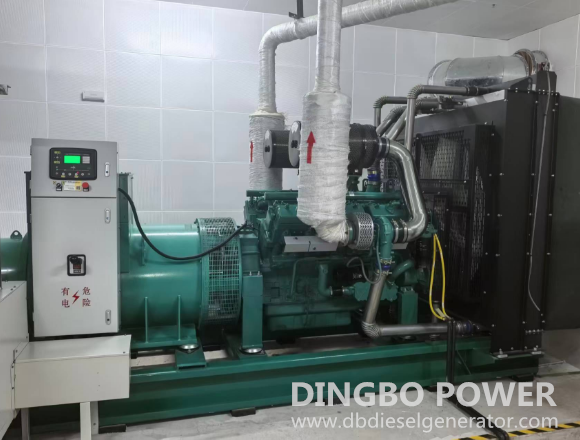dingbo@dieselgeneratortech.com
+86 134 8102 4441

- Home
- Products
- About Us
- Service
- News
- Technical Support
- Contact Us
dingbo@dieselgeneratortech.com
+86 134 8102 4441
Nov. 15, 2025
As a universal component, the diesel generator exhaust pipe plays a crucial role in discharging waste gas and smoke in many generator sets. A well-designed exhaust system ensures that the waste gas and smoke generated during the operation of the generator set are effectively discharged outdoors, thereby minimizing impact on the surrounding environment and the work and life of residents. The design of a generator set exhaust system must comprehensively consider factors such as exhaust efficiency, safety, environmental protection, and equipment lifespan.
Material: Typically made of carbon steel or stainless steel, requiring high temperature and corrosion resistance.
Structure: Includes straight pipes, elbows, tees, etc., requiring a rational layout to minimize resistance.
Insulation: High-temperature exhaust pipes require insulation layers to prevent heat loss and burn risks.
Function: Reduces exhaust noise and minimizes environmental impact.
Types: Includes resistive mufflers (absorb high-frequency noise) and reactive mufflers (eliminate low-frequency noise), or composite mufflers.
Function: Absorbs thermal expansion and vibration in the pipeline, preventing pipe rupture.
Installation Location: Typically installed between fixed supports of the exhaust pipeline.
Applicable Scenarios: Used when natural exhaust is insufficient, such as for long-distance exhaust or when overcoming significant resistance.
Selection: Choose an appropriate fan based on exhaust volume, pressure loss, and altitude.
Height requirements: Must comply with local environmental regulations, typically requiring a height above the building to avoid smoke stagnation.
Rain cap: Prevents rainwater from entering the exhaust pipeline.
Particulate filters: Such as Diesel Particulate Filters (DPF), to reduce particulate matter emissions. Catalytic oxidizers: Oxidize carbon monoxide (CO) and hydrocarbons (HC). Selective catalytic reduction (SCR) Systems: Reduce nitrogen oxides (NOx) emissions.
Fixed supports: Support the exhaust pipeline, requiring consideration of thermal expansion and vibration.
Guide supports: Allow axial movement of the pipeline while restricting lateral displacement.

Pipeline resistance: Calculated based on pipeline length, diameter, number of elbows, and surface roughness.
Muffler resistance: Refer to resistance curves provided by the manufacturer.
Exhaust backpressure: Must be lower than the maximum backpressure allowed by the generator set (usually provided by the manufacturer).
High-temperature protection: Exhaust temperatures typically range from 400–600°C, requiring measures to prevent burns and fire risks.
Insulation materials: Select high-temperature-resistant insulation materials, such as aluminum silicate fiber or rock wool.
Noise standards: Must comply with local environmental requirements, such as the Emission Standard for Industrial Enterprises Noise at Boundary.
Noise reduction measures: Optimize muffler design, add acoustic enclosures or soundproof walls.
Pollutant limits: Must meet local environmental regulations for pollutants such as particulate matter, NOx, and CO.
Monitoring and reporting: Install emission monitoring equipment and regularly report emission data.
Fire and explosion prevention: Exhaust pipelines must be kept away from flammable materials, with fire dampers and explosion-proof discs installed.
Leak detection: Install leak alarm devices to promptly detect pipeline leaks.

1. Requirement analysis: Determine generator set power, exhaust volume, emission standards, and site conditions.
2. System selection: Choose between natural exhaust or forced exhaust, and determine whether emission control devices are needed.
3. Pipeline design: Calculate pipeline diameter, length, and resistance, and select appropriate materials and insulation methods.
4. Equipment selection: Select mufflers, bellows compensators, exhaust fans, etc., ensuring performance compatibility.
5. Installation and commissioning: Install pipelines and equipment according to design drawings, and conduct pressure tests and noise tests.
6. Acceptance and maintenance: Verify emission compliance, establish a regular maintenance plan, including cleaning mufflers and inspecting pipeline corrosion.
Causes: Pipeline diameter too small, excessive elbows, high muffler resistance.
Solutions: Increase pipeline diameter, reduce elbows, optimize muffler design.
Causes: Inadequate muffler performance, pipeline vibration.
Solutions: Replace with high-efficiency mufflers, add soundproofing materials, reinforce pipeline supports.
Causes: Malfunctioning emission control devices, poor fuel quality.
Solutions: Repair or replace emission control devices, use qualified fuel.
Causes: High-temperature and high-humidity environments, insulation failure.
Solutions: Replace with corrosion-resistant materials, enhance insulation maintenance.
The design of a generator set exhaust system requires comprehensive consideration of mechanical, thermal, environmental, and safety factors. Through rational selection, precise calculation, and strict construction, the system can operate efficiently, safely, and in an environmentally friendly manner. It is recommended to consult professional engineers during the design phase and adhere to local regulations and standards.
Previous None
Next Diesel Generator Sets in High-Altitude Oxygen Deficiency Condition
Quicklink
Mob.: +86 134 8102 4441
Tel.: +86 771 5805 269
Fax: +86 771 5805 259
E-mail: dingbo@dieselgeneratortech.com
WhatsApp: +86 134 8102 4441
Add.: No. 10 Kechuang Road, High tech Zone, Nanning, Guangxi, China